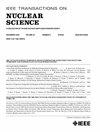Machine Learning-Based Extreme Data Reduction for Prompt Supernova Pointing at DUNE
IF 1.9
3区 工程技术
Q3 ENGINEERING, ELECTRICAL & ELECTRONIC
引用次数: 0
Abstract
One of the goals of the Deep Underground Neutrino Experiment (DUNE) is to use the massive underground liquid argon time projection chamber (LArTPC) detectors at its far site for multimessenger astronomy (MMA), in the detection of neutrinos from core-collapse supernovae (SNe). Its current baseline trigger strategy detects activity in the detector that is consistent with supernova (SN) neutrinos and saves the raw data for further offline analysis but provides no prompt pointing information crucial for optical follow-ups by other observatories. This approach is based on the assumption that prompt pointing determination using raw data is computationally prohibitive. In this article, we demonstrate a proof-of-concept based on applying extreme data reduction on the buffered SN data in the DUNE data acquisition (DAQ) system’s front-end computers using a machine learning (ML) workflow. This reduces the data by ~5 orders of magnitude, allowing a full track reconstruction to be carried out quickly on a single server. The total time to perform the ML-based data reduction and the full track reconstruction is less than the time to transfer the SN data back to Fermilab or a high-performance computing (HPC) center. This shows that prompt processing of raw SN data is possible and, in fact, trivial once the data have been reduced to reject radiological backgrounds, paving the way to a high-quality SN pointing trigger that is based on fully reconstructed data instead of trigger primitives (TPs).求助全文
约1分钟内获得全文
求助全文
来源期刊

IEEE Transactions on Nuclear Science
工程技术-工程:电子与电气
CiteScore
3.70
自引率
27.80%
发文量
314
审稿时长
6.2 months
期刊介绍:
The IEEE Transactions on Nuclear Science is a publication of the IEEE Nuclear and Plasma Sciences Society. It is viewed as the primary source of technical information in many of the areas it covers. As judged by JCR impact factor, TNS consistently ranks in the top five journals in the category of Nuclear Science & Technology. It has one of the higher immediacy indices, indicating that the information it publishes is viewed as timely, and has a relatively long citation half-life, indicating that the published information also is viewed as valuable for a number of years.
The IEEE Transactions on Nuclear Science is published bimonthly. Its scope includes all aspects of the theory and application of nuclear science and engineering. It focuses on instrumentation for the detection and measurement of ionizing radiation; particle accelerators and their controls; nuclear medicine and its application; effects of radiation on materials, components, and systems; reactor instrumentation and controls; and measurement of radiation in space.
 求助内容:
求助内容: 应助结果提醒方式:
应助结果提醒方式:


